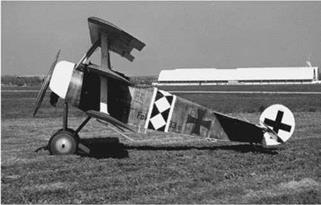Triplane
A triplane is a fixed-wing aircraft equipped with three vertically-stacked wing planes. Tailplanes and canard fore-planes are not normally included in this count, although they may occasionally be. A typical example for triplane is the Fokker Dr. I of World War I, shown in Figure 1.7.
|
Figure 1.7 Fokker Dr. I of World War I. |
The triplane arrangement may be compared with the biplane in a number of ways. A triplane arrangement has a narrower wing chord than a biplane of similar span and area. This gives each wing plane a slender appearance with a higher aspect ratio, making it more efficient and giving increased lift. This potentially offers a faster rate of climb and tighter turning radius, both of which are important in a fighter plane. The Sopwith Triplane was a successful example, having the same wing span as the equivalent biplane, the Sopwith Pup.
Alternatively, a triplane has a reduced span compared with a biplane of given wing area and aspect ratio, leading to a more compact and lightweight structure. This potentially offers better maneuverability for a fighter plane, and higher load capacity with more practical ground handling for a large aircraft type.
The famous Fokker Dr. I triplane was a balance between the two approaches, having moderately shorter span and moderately higher aspect ratio than the equivalent biplane, the Fokker D. VI.
Yet a third comparison may be made between a biplane and triplane having the same wing planform— the triplane’s third wing provides increased wing area, giving much increased lift. The extra weight is partially offset by the increased depth of the overall structure, allowing a more efficient construction. The Caproni Ca.4 series had some success with this approach.
These advantages are offset, to a greater or lesser extent in any given design, by the extra weight and drag of the structural bracing, and the aerodynamic inefficiency inherent in the stacked wing layout. As biplane design advanced, it became clear that the disadvantages of the triplane outweighed the advantages.
Typically the lower set of wings are approximately level with the underside of the aircraft’s fuselage, the middle set level with the top of the fuselage, and the top set supported above the fuselage on cabane struts.












